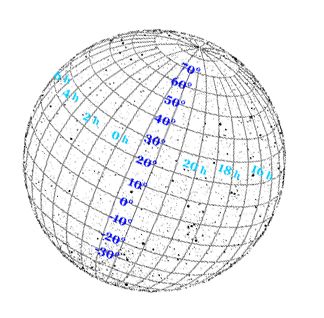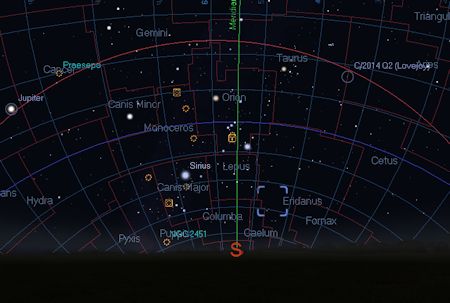

Let's Get Our Bearings
The celestial sphere has a coordinate system that, at first glance, seems just a bit esoteric. For example, Betelgeuse has coordinates 5 hours, 55 minutes by +7 degrees and 24 minutes (5h55m, +7°24'). So let's get to know this system a bit. It is actually quite useful.

The first number is the Right Asencion and the second is Declination. Right Asencion is divided into 24 hours and measured from the point on the celestial sphere where the sun crosses the equator at vernal equinox. So the sun is at 0 hours of RA on the first day of spring and at 12 hours on the first day of fall. But from a night sky observer's point of view, it might be better to figure out where things are in the night sky regarding right asencion.
Of greatest interest to the night observer is when objects rise, set, and cross the meridian (due south). When an object is due south, it is at the highest point above the horizon and thus is the best time to observe. First, we'll choose some logical reference time when it is always dark. Midnight seems like a nice cardinal time. But we'll have to pay attention to daylight savings time, so our reference time will be 1:00 AM during DST. So, on March 21, the sun is at 0 hours, thus we'd expect the 12th hour of celestial longitude to cross the meridian at midnight standard time. At the longitude of my house, the 12th hour crosses the meridian about 4 days later due to my position our time zone. The dividing line between the constellations Leo and Virgo is approximately at the 12th hour. It passes through Ursa Major with the Dipper star Phad being within 4 minutes of the demarcation. The second brightest star in Leo, Denebola, is also a few minutes from the 12th hour line.

The 18th hour is home to the Trifid Nebula and Sagittarius, while Vega is between hour 18 and 19. The 18th hour crosses the meridian at 1:00 AM (midnight standard time) on 6/26/14. Again, this should happen on summer solstice in the center of a time zone. On September 25th, zero hour coincides with standard time midnight. At zero hour, the ecliptic crosses the equator in Pisces. Caph, the west-most star in Cassiopeia's W is a few minutes from zero while the Andromeda galaxy is about 45 minutes east. The 6th hour crosses the meridian at midnight on Christmas night and is the location of Betelgeuse and the dividing line between Gemini and Taurus. Notice in the table below that dates of meridian crossing hours are about 15 days apart.
| Hour | Date of 0:00 Meridian |
Constellations | Stars/Objects | Hour | Date of 0:00 Meridian |
Constellations | Stars/Objects | |
|---|---|---|---|---|---|---|---|---|
| 0 | 9/25 | And | Caph | 12 | 3/26 | Cen, Vir | Phad, Denebola | |
| 1 | 10/10 | Phe, Cet, Psc, Cas | M31, Mirach | 13 | 4/11 | Vir, Com, CVn | Virgo Cluster, Alioth | |
| 2 | 10/25 | Tri | Hamal | 14 | 4/26 | Cen, Vir, Boo | Arcturus, Alkaid | |
| 3 | 11/10 | For, Ari | Algol, Polaris | 15 | 5/11 | Lib, Boo, UMi | Kochab | |
| 4 | 11/25 | Eri, Tau, Per | Pleiades | 16 | 5/26 | Nor,Lup, Ser, CrB | ||
| 5 | 12/10 | Cae, Lep, Ori | Rigel, Capella | 17 | 6/10 | Sco, Oph, Her, Dra | M10, M19, M62 | |
| 6 | 12/25 | Col, Lep, Ori, Aur, Cam | Betelgeuse | 18 | 6/26 | Ser, Dra | M7, M20 | |
| 7 | 1/9 | CMa, Mon, Gem | Sirius | 19 | 7/11 | CrA, Sag, Scu, Lyr | ||
| 8 | 1/25 | Pup, Lyn | Naos, Pollux | 20 | 7/26 | Sag, Aqu, Vul, Cyg | Altair | |
| 9 | 2/9 | Vel, Pyx, Hyd, Can | M44 | 21 | 8/10 | Mic, Cap, Equ, Del | Veil Nebula | |
| 10 | 2/24 | Ant, Sex, LMi | Regulus | 22 | 8/25 | Gru, PAu, Aqu, Peg | Cocoon Nebula | |
| 11 | 3/11 | Cra, Leo, UMa | Merak | 23 | 9/10 | Aqu, Peg, Lac, Cep | Formalhaut, Scheat |
The other component of apparent celestial addresses is Declination ranging from +90° to -90°. At my lattitude, the declination of an object that intersects the zenith is about +42°. Of course, the zenith is always located on the meridian. The southern most objects theoretically visible are visible when they cross the meridian and have declinations of -47. Due to horizon haze, -42° is probably a more realistic limit. At my lattitude, the Celestial Equator intersects the meridan at about 48° above the southern horizon. The ecliptic is the path traced by the sun. On the first day of winter, the sun is at its low point for the year, rising only to about 29 1/2 degrees above the southern horizon at solar noon. But at midnight, the ecliptic intersects the meridian near Messier 35 at 71 1/2 degrees above the southern horizon. Since the planets also roughly follow the ecliptic, they are their highest in the sky, when present, during winter.
| -40° | Naos |
| -30° | M54, M83, Antares |
| -20° | M23, M25, Sirius |
| -10° | Spica, Rigel |
| 0° | Mintaka, M2 |
| +10° | Altair, Regulus |
| +20° | Arcturus |
| +30° | Pollux, M33 |
| +40° | Vega, Andromeda |
| +50° | Mirphak, M39 |
| +60° | Caph, Soul Nebula |
| +70° | M82 |
| +80° | |
| +90° | Polaris |
Objects at more southerly declinations are in the sky for a shorter amount of time each night, while stars above +60 are circumpolar. Below is a table giving the length of time between when a star rises and sets for a given declination at my lattitude.
| -30° | 2h 30m |
| -20° | 3h 30 m |
| -10° | 4h 30 m |
| 0° | 5h |
| +10° | 5h 40m |
| +20° | 6h 20m |
| +30° | 7h |
| +40° | 7h 45m |
| +50° | 8h |
| +60° | Circumpolar |
The last thing to think about is when astronomical twighlight occurs. We see from the table below that mid June has 4 1/2 hours of darkness, while Christmas has about 11 1/2 hours. So, the Orion Nebula is at 5h35m and -5°27m. Glancing at my hour table above, I see that 7h30m will cross my meridian at midnight tonight. So the Orion Nebula will cross it at about 10 PM. And from my declination table, I see that it will rise a little less than 4 hours before that. So it will be above the horizon at dark. And one final observation: Late October has long and early nights, while it is still warm. Furthermore, skies a more likely to be clear than early spring, so late October is prime observing season!
| Date | Night | Morning | Date | Night | Morning | |
|---|---|---|---|---|---|---|
| 9/25 | 8:41 PM | 5:33 AM | 3/26 | 9:10 PM | 5:35 AM | |
| 10/10 | 8:17 PM | 5:49 AM | 4/11 | 9:32 PM | 5:03 AM | |
| 10/25 | 7:53 PM | 6:07 AM | 4/26 | 9:55 PM | 4:34 AM | |
| 11/10 | 6:37 PM | 5:24 AM | 5/11 | 10:20 PM | 4:06 AM | |
| 11/25 | 6:26 PM | 5:41 AM | 5/26 | 10:44 PM | 3:43 AM | |
| 12/10 | 6:25 PM | 5:52 AM | 6/10 | 11:02 PM | 3:30 AM | |
| 12/25 | 6:31 PM | 6:02 AM | 6/26 | 11:08 PM | 3:30 AM | |
| 1/9 | 6:43 PM | 6:04 AM | 7/11 | 10:59 PM | 3:43 AM | |
| 1/25 | 6:59 PM | 5:58 AM | 7/26 | 10:39 PM | 4:05 AM | |
| 2/9 | 7:16 PM | 5:45 AM | 8/10 | 10:12 PM | 4:29 AM | |
| 2/24 | 7:33 PM | 5:26 AM | 8/25 | 9:43 PM | 4:52 AM | |
| 3/11 | 8:51 PM | 6:02 AM | 9/10 | 9:11 PM | 5:14 AM |